Self Portrait

From the Bulgarian National Gallery site: Georgi Mashev was born on 1 January 1887 in Pazardzhik, the son of the National Revival teacher, Petko Mashev. He studied painting in 1906–1907 at the State School of Drawing in Sofia, under Prof. Petko Klisurov. A year later (1907–1908), he attended the Art Academy in St. Petersburg. Mashev returned to Bulgaria and studied law in Sofia for one year, before leaving for Brussels, where, between 1910 and 1911, he studied painting at the Art Academy under Prof. Edmond Richard. Following his return to his home country, he graduated in 1912 from the Industrial School of Arts (the Academy of Fine Arts) in Sofia under Prof. Ivan Mrkvička.
During the First World War, he was a war artist (1915–1918) with the Cavalry Division of the Bulgarian Army. Between 1929 and 1939, he worked as an artist at the Ministry of National Enlightenment. Under the pseudonyms Mashoka and Charni, he contributed to the newspapers ‘Osa’ [wasp], ‘Bulgar’, ‘Den’ [day], ‘Baraban’ [drum], ‘Kambana’ [chime], ‘Smyah’ [laughter], and ‘Balkan Tribune’, with caricatures and satirical drawings; his caricatures targeting Ferdinand’s regime became popular. He held his first solo exhibition in Sofia in 1915. In 1930, he worked in Paris and, in 1931, exhibited his painting, ‘Female Portrait’, at the Autumn Salon; he also participated in the ‘Exhibition of the 100’ (an exhibition of French artist-humourists) with his ‘Adam and Eve’ cycle. He was involved in the sphere of portraiture, composition, and landscape. His pictorial works are symbolically tinted, with many depicting folklorically mythological themes. He also actively painted historical compositions. In 1941, he won first prize in the competition of the Ministry of National Enlightenment for his canvas ‘Tsar Simeon Returns to Preslav after Victory’.
He died of tuberculosis in 1946 in Sofia.


Congratulations on the birth of your… middle aged accountant with male pattern baldness.